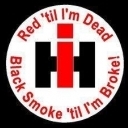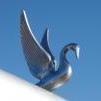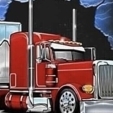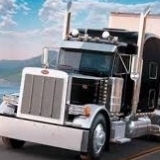Leaderboard
Popular Content
Showing content with the highest reputation since 09/05/2015 in all areas
-
8 pointsBuilt almost entirely with left over parts from other kits. Holmes 750 style wrecker unit entirely scratch-built.
-
5 pointsHere’s a 359 I built about 18 months ago, but never posted here. Representing a modern day version of a truck that is still serving it’s owner well after all the years. I posted it on the MCM forum, so some of you may have seen it already. It was an enjoyable build, and my second venture into weathering, which I now find to be much easier to build than a showroom clean model - it’s harder to screw it up, mistakes can be disguised. Thanks for checking it out.
-
4 pointsModelled after a real wrecker used by a local towing company. Real wrecker weighs 103,000-pound necessitating 5 axles and special permits to operate in most states. Boom rotates 360 degrees and is poseable. It has a scale 8 feet of travel on the frame. Model is almost completely scratch-built using styrene plastic sheets and structural shapes.
-
4 points
-
4 pointsThanks for the comments guys! Been moving slow on this one, not because of excellence, I'm just moving slow.😀 It is on its wheels and tires now.
-
3 points
-
3 pointsWith my farm chores backing up on me, I didn't have much bench time this weekend. I did manage to make new mudflaps (thanks for stealing one kitty cat) The hangers are a little on thick side, but they'll do the job.
-
3 pointsFuel tanks coming together, more detail work. Visor is scratch built and ready for final fit. Grill stripped, all goobers removed and rechromed.
-
3 pointsWell the weather becoming cold and snowing here, so I can get some bench time this week. Added some more color to the hood (too much white). Still working out the fuel tanks and roughing out a new visor.
-
3 pointsHere's some pics of my new 1926 Mack Stake truck. Built box stock with custom built racks and some mild oil and dirt staining which is hard to see in the pictures. This was the log truck version, but I wasn't crazy about the load so I decided to change the bed. I did find certain things that I didn't like in this kit, like poor locater marks and some fitment issues but nothing insurmountable. All in all, I think it looks like a nice model of an historic truck. Sorry about the small pics; for some reason the pictures won't transfer correctly from the camera to the computer.
-
3 pointsThis is currently my only truck build. It's meant to be a Post Apocalypses RV that was patched together from various bits to roam the wasteland. I started with an Autocar Dump Truck and Italeri 20' Container. Reefer unit converted to HVAC system, Air Filtration, Power Fan, Custom front bumper and a frame mounted generator to name a few of the upgrades. Stretched frame, new wheels and tires, pusher axle and many 3d printed parts leads us to where we are today. Occasionally I add a few more bits to it as I find or design files. Hope you enjoy, I know it's a bit different from what you're used to.
-
3 points
-
3 pointsI finished this build right before Christmas last year. No frame stretch, just removed sleeper and scratch built the flatbed and fuel tanks.
-
3 pointsThis was a resin conversion from an unknown caster. The chassis was made from spare parts.
-
3 pointsI finally finished it...for now... I may go back and touch up a few thing. I built this truck for an online contest over at The Unfinished Big Rig Model Truck Club on Facebook. I didn't fair as well in the voting as I hoped it would. Maybe I'll do better next time. Regardless, it was a great learning experience. The concept was to create a resto-mod COE Freightliner. I started with a fresh AMT COE Freightliner Kit. All other lifted parts were salvaged from the parts box. Chassis: Frame stretch using the rails from an AMT Peterbilt. Air ride suspension from an Italeri FLD 120 Engine: Cummins engine from an Italeri FLD 120 modified into an N14 (new heads, valve covers, fuel pump, etc.). Air to air setup was added to the radiator. Plumbing and hoses were built from the parts box and misc. wire. Clamps chrome sticker. Cab: Scratch built visor. Snap Pete mirrors. Rear fenders: Scratch built. Fifth wheel: ROG Peterbilt. Deck plates and rear light panel: scratch built from styrene Cab Steps: Scratch built. Fuel tanks: Stretched using like tanks from parts box. Air cleaners: ROG Peterbilt. Scratch built piping and parts box plumbing. Stack tops: Tubing wrapped in chrome sticker. Air Lines: Earl Miller. Wheels and tires: Mobius.
-
3 points
-
3 points
-
3 pointsThis one began with the Ertl kit. The engine is a 6v-92T Detroit diesel. The dump bed was modified. It is meant to look like a refurbished truck that has found new life from someone wanting to start out in the dump trucking business. IMG_4675 by Brian Smith, on Flickr IMG_4646 by Brian Smith, on Flickr IMG_4650 by Brian Smith, on Flickr IMG_4639 by Brian Smith, on Flickr IMG_4641 by Brian Smith, on Flickr IMG_4625 by Brian Smith, on Flickr IMG_4666 by Brian Smith, on Flickr IMG_4676 by Brian Smith, on Flickr IMG_4685 by Brian Smith, on Flickr IMG_4693 by Brian Smith, on Flickr
-
3 pointsRebuilding this IH dump I've had on the self for the last 40 years - I know, hard to believe that Ertl kit dates back to the mid 1970's. The first couple of pics is the original build with the dump bed removed, I did weather it some back then and that will remain. The new winch deck and everything thing else will be weathered slightly as this represents a working truck. I mean it is and IH after all ! The dual winches come from the discontinued Revell drop deck trailer #07533. Everything else is scratchbuilt. The cab/hood will be removed, reworked and repainted white with the lower half the same yellow to match the deck. The hydraulic oil tank caps both come off and are accessed by a hatch in the deck. I made all the hyd fittings and lines both soft and hard. Used a schematic found online for proper routing. More to follow when finished. Keep on truckin America !!
-
3 pointsIt looks like this barn find may need some work. There's a box on the front seat with the starter, the distributor, the carb, the air cleaner, and some tools. There's a brand new valve cover gasket though. All of the spark plugs are out of the engine and there's a can of Marvel Mystery Oil, so the engine is probably stuck. Maybe that's why there's a For Sale sign in the box too. IMG_1384 by Brian Smith, on Flickr IMG_1385 by Brian Smith, on Flickr IMG_1386 by Brian Smith, on Flickr IMG_1387 by Brian Smith, on Flickr IMG_1389 by Brian Smith, on Flickr IMG_1390 by Brian Smith, on Flickr
-
3 pointsthis is a fairly old build.If my stuff turns out as nice as this one I'm happy,as its my favorite
-
3 pointsBy filling in the square space left from removing the headlight surround with sheet styrene, one can minimize the amount of filler needed. I'm leery of Squadron putties, and they will shrink over time. I suggest superglue plus baking powder, or a two-part polyester putty like Evercoat.
-
3 pointsCool! I am building a real 4200 with a Mercury and the same scheme on the truck. Pic is photo shopped as she is still a day cab.
-
3 pointsWork continues! The fenders were modified to give them an "old-school" kind of look, and to eliminate the huge gap between the fender lip and the tops of the tires. I also built up the kit bumper to a deep-draw bumper. I see 1:1 Pete's with fenders like these, but the bumper just has straight edges, and I just think it looks weird. I prefer the bumpers which continue the arc of the wheel opening, so that's what I did with mine. And now a quick mockup of the modified (but still unfinished) fenders and bumper with the grille in place, just to see where I stand.
-
3 pointsI build a variety of model types- everything from HO scale buildings to RMS Titanic. But my favorite thing about the big truck kits is variation. There aren't too many other genres you can build in so many ways. Take the AMT Diamond REO. Right out of the box it makes a decent day cab or sleeper tractor. Or you can modify the hood (or get the hood from GW Trucks) and do it with a set back front axle. You could make up the steel butterfly hood and pit fenders for it. Or rework the existing grille to the earlier style... or even built it as a Diamond T or REO. You can leave it a tractor, or put a wrecker body on it. Or a cement mixer. Or a dump box... That's just one example, but you see what I mean. You can name pretty much any one truck kit out there, and then go on to come up with at least 20 or 30 different ways you could build it.


.thumb.jpg.1134de5f0416b74d25519d3d400538d3.jpg)


